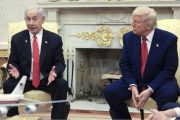
As the drone war expands in Africa and Syria, the Department of Defense is finding that some of the pilots pulling the triggers on the unmanned vehicles are having a hard time dealing with the stress of summary executions.
The program is MQ-1 Predator and MQ-9 Reaper Culture and Process Improvement Program (CPIP), and it was introduced at the end of August.
In a statement released by the Air Force, Colonel Troy Jackson explains its purpose.
“A lot of assumptions were made over the years, and people don’t realize how stressful and overworked the MQ-1/9 field is,” said Jackson, the command and control intelligence, surveillance, and reconnaissance operations division chief and CPIP officer in charge. “We’re asking Airmen to do a lot when they’re either not trained properly or not ready for what’s being asked of them, which leaves the Airmen burned out.”
“A lot of assumptions were made over the years, and people don’t realize how stressful and overworked the MQ-1/9 field is,” Jackson added.
In fact, one would imagine that those unfortunate enough to have been caught within a “signature strike” kill zone, or who have had a loved one in this situation, know a little bit about how “stressful” the drone war can be.
Of course, the drone pilots wouldn’t be so stressed and overworked if the president would stop ordering them to kill so many people in so many countries. As of today, those deadly missions are being flown in Afghanistan, Iraq, Somalia, Pakistan, Yemen, and Syria.
Jackson believes that the drone pilots are getting “burned out” and the Pentagon should take a “holistic” approach to treating this malady. One of the methods used by the Air Force to help relieve the stress is the creation of a Facebook page and a blog.
According to various media reports on the CPIP online tools (e.g., click here), the blog originally included memes using humor to advertise and promote the CPIP mission. These memes have since been removed.
What persists, however, is the problem of mental trauma suffered by those tasked with killing suspected enemies thousands of miles away.
Again, would the members of the United States Armed Forces not be better served by eliminating the source of the trauma rather than treating its effects?
And, the cause of the suffering is the unconstituitonal expansion of preemptive war, while the cure is a return to the proper, constitutionally prescribed use of authority and war-making power.
The problem with pilot PTSD has been percolating for a while now. A story published by Salon in 2013 reported on the disconcerting decline of drone pilot mental health:
On January 4, 2015, the Daily Beast revealed an undated internal memo to Air Force Chief of Staff General Mark Welsh from General Herbert “Hawk” Carlisle stating that pilot “outflow increases will damage the readiness and combat capability of the MQ-1/9 [Predator and Reaper] enterprise for years to come” and added that he was “extremely concerned.” Eleven days later, the issue got top billing at a special high-level briefing on the state of the Air Force. Secretary of the Air Force Deborah Lee James joined Welsh to address the matter. “This is a force that is under significant stress — significant stress from what is an unrelenting pace of operations,” she told the media.
Perhaps the most pressing concern to the Pentagon is the incompatibility of an expanding theater for the drone war and a reduction in the number of airmen willing to pilot the devices. Again, from Salon:
The Air Force is currently under orders to staff 65 of these regular “combat air patrols” around the clock as well as to support a Global Response Force on call for emergency military and humanitarian missions. For all of this, there should ideally be 1,700 trained pilots.
Instead, facing an accelerating dropout rate that recently drove this figure below 1,000, the Air Force has had to press regular cargo and jet pilots as well as reservists into becoming instant drone pilots in order to keep up with the Pentagon’s enormous appetite for real-time video feeds from around the world.
The Air Force explains the departure of these drone pilots in the simplest of terms. They are leaving because they are overworked. The pilots themselves say that it’s humiliating to be scorned by their Air Force colleagues as second-class citizens. Some have also come forward to claim that the horrors of war, seen up close on video screens, day in, day out, are inducing an unprecedented, long-distance version of post-traumatic stress syndrome (PTSD).
For many years the media have reported on drone operators’ psychological fallout from firing missiles at targets thousands of miles away in a manner more like a video game than a combat mission.
In a lengthy story about one former drone pilot’s increasing mental instability, GQ included some data on the Pentagon’s push to diagnose the pilots with PTSD:
In 2011, Air Force psychologists completed a mental-health survey of 600 combat drone operators. Forty-two percent of drone crews reported moderate to high stress, and 20 percent reported emotional exhaustion or burnout. The study’s authors attributed their dire results, in part, to “existential conflict.” A later study found that drone operators suffered from the same levels of depression, anxiety, PTSD, alcohol abuse, and suicidal ideation as traditional combat aircrews.
So, while drone pilots pull triggers and kill people with no more due process than a CIA green light or presidential permission, the Air Force decides that the best way to stem the rising tide of trauma among the operators is to create a blog where they’ll post “funny” pictures, hoping that laughter will be the best medicine.
Of course, the American people could put a stop to this silliness by holding elected officials accountable, forcing them to remain faithful to their oaths of offices to be bound by the chains of the Constitution.
This would accomplish the twin goals of healing those whose sanity is being sacrificed on the altar of empire and buttressing the barriers to autocracy built by the founding fathers in the Constitution.
According to the latest data, nearly 2,500 people have been killed in U.S. drone strikes since Barack Obama’s inauguration in 2009, including four American citizens.
Photo of drone pilots: U.S. Air Force



